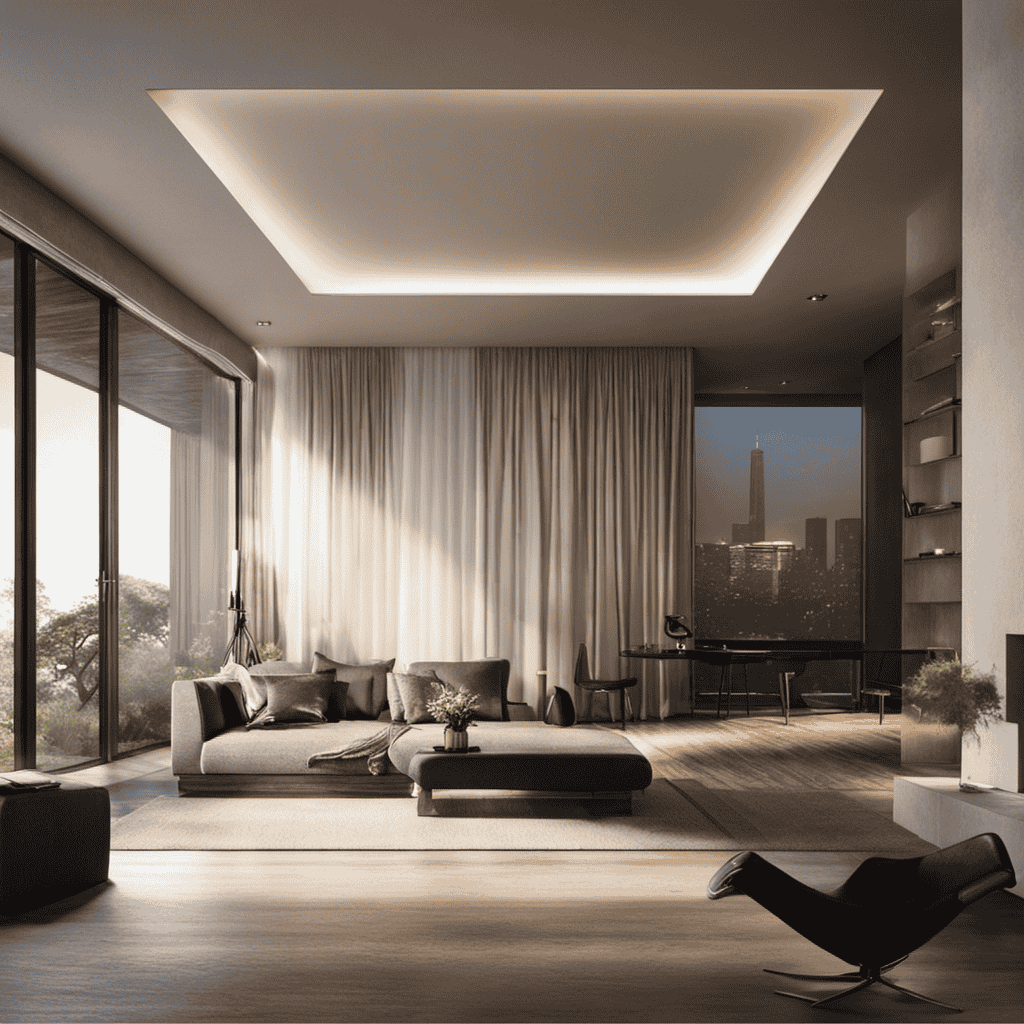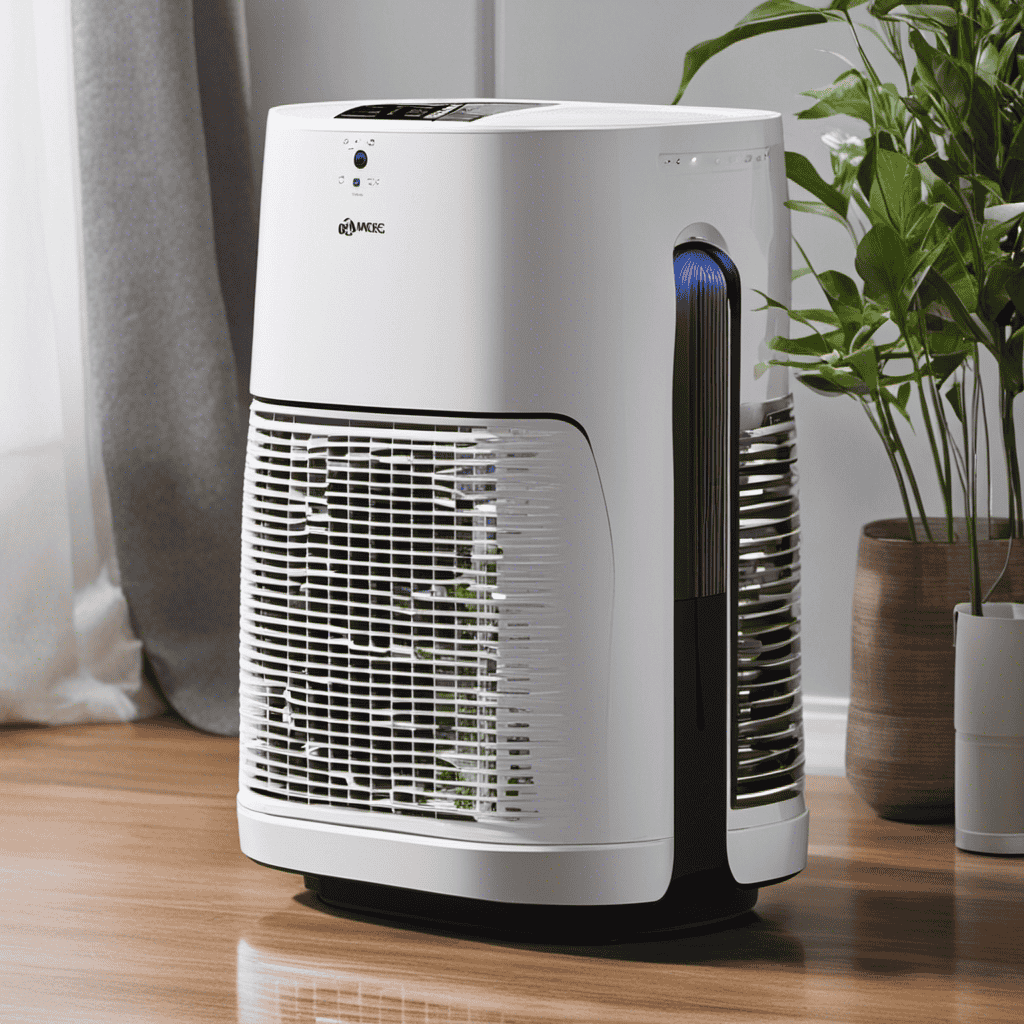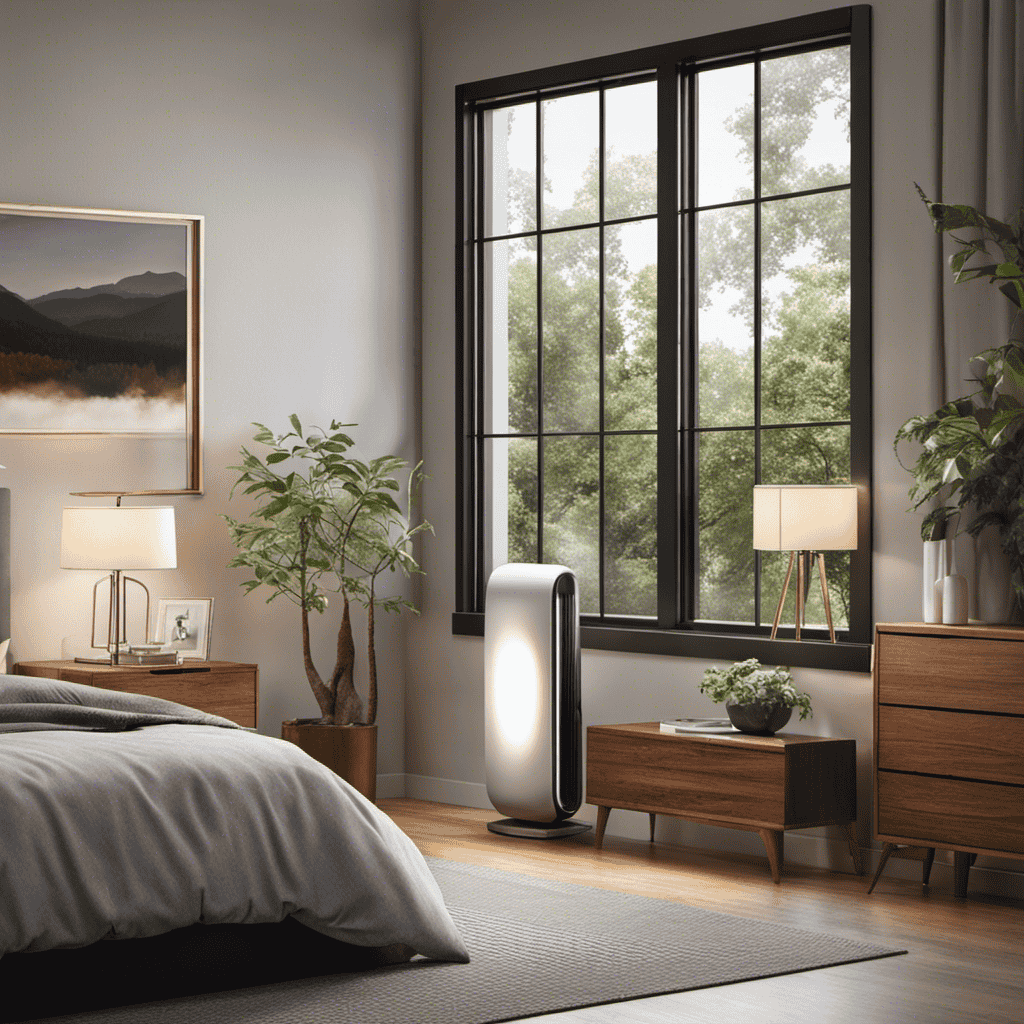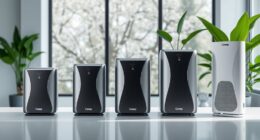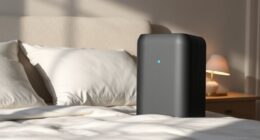I’ve always been curious about the actual effectiveness of air purifiers, and I’m sure you are too.
Did you know that indoor air pollution can be two to five times higher than outdoor pollution? That’s why it’s crucial to have a reliable way to determine if your air purifier is actually doing its job.
In this article, we’ll explore the various methods and indicators that can help you assess the effectiveness of your air purifier, ensuring that you and your loved ones breathe clean and healthy air.
Key Takeaways
- Air quality monitors provide an objective way to assess the performance of an air purifier.
- Significant decrease in pollutant levels on the monitor indicates effective removal of indoor pollutants.
- Regular monitoring ensures the effectiveness of the air purifier in maintaining a healthy living environment.
- Signs of an effective air purifier include reduction in dust particles, decreased presence of allergens and irritants, improved air circulation and freshness, and decreased odors and cooking smells.
Air Quality Monitoring
You can check if an air purifier is working by using an air quality monitor. Indoor pollution, particularly air pollution, is a significant concern for many people. It is crucial to have a reliable method for determining the effectiveness of an air purifier in reducing indoor pollutants. An air quality monitor serves as a valuable tool in this regard.
Air quality monitors measure various pollutants present in the air, such as particulate matter, volatile organic compounds (VOCs), and carbon dioxide levels. By comparing the air quality readings before and after using an air purifier, you can evaluate its performance. If the monitor shows a significant decrease in pollutant levels, it indicates that the air purifier is effectively removing indoor pollutants.
Scientific studies have shown that air purifiers can effectively reduce indoor pollution levels. However, the specific effectiveness of an air purifier may vary depending on factors such as the size of the room, the type of pollutants present, and the efficiency of the purifier itself. Therefore, using an air quality monitor provides an objective way to assess the performance of an air purifier and ensure that it is efficiently improving indoor air quality.
Performance Indicators
To gauge the effectiveness of an air purifier, look out for performance indicators such as the noise level, fan speed, and filter replacement alerts. These indicators can provide valuable insights into the functionality and efficiency of the device.
-
Noise Level:
A low noise level is desirable as it ensures a peaceful environment. Look for air purifiers with noise levels below 50 decibels for minimal disruption to your daily activities. Some advanced models have a sleep mode that further reduces noise levels during nighttime operation, allowing for undisturbed sleep. -
Fan Speed:
The fan speed determines how quickly the purifier can circulate and filter the air in a room. Higher fan speeds generally result in faster purification but can also produce more noise. Look for air purifiers with adjustable fan speeds to customize the level of purification based on your needs and preferences. -
Filter Replacement Alerts:
Regular filter maintenance is crucial for optimal performance. Look for air purifiers that have filter replacement alerts to ensure timely replacements and maintain the efficiency of the device.
In addition to these performance indicators, it is also important to consider energy consumption efficiency when evaluating an air purifier. Look for models with Energy Star certification, as they have been tested and proven to meet strict energy efficiency guidelines, saving you money on electricity bills while helping the environment.
Filter Efficiency Testing
Filter efficiency testing is a crucial step in determining the effectiveness of an air purifier. When it comes to indoor pollution, particle measurement plays a vital role in assessing the quality of air. To ensure that an air purifier is truly effective in removing harmful particles from the air, filter efficiency testing is necessary.
During filter efficiency testing, various types and sizes of particles are introduced into the air, simulating real-life scenarios of indoor pollution. These particles can range from common allergens like pollen and dust mites to more harmful pollutants like smoke and mold spores. The air purifier is then evaluated based on its ability to filter out these particles effectively.
Particle measurement techniques, such as laser particle counters, are used to measure the concentration of particles in the air before and after filtration. This allows us to quantify the performance of the air purifier and determine its efficiency in removing particles of different sizes.
By conducting filter efficiency testing, we can confidently determine whether an air purifier is capable of reducing indoor pollution effectively. This testing provides scientific evidence that validates the effectiveness of the air purifier in improving indoor air quality.
In the subsequent section about odor and allergen reduction, we will explore how air purifiers can also target and eliminate unpleasant odors and allergens from the air.
Odor and Allergen Reduction
Air purifiers can effectively reduce odors and allergens in the air, providing a fresher and healthier indoor environment. When considering the effectiveness of an air purifier, it is important to understand how it works and what it can do for your indoor air quality.
Here are some key points to consider:
-
Odor Reduction:
-
Air purifiers equipped with activated carbon filters are particularly effective in reducing odors. The activated carbon absorbs and traps odorous molecules, eliminating unpleasant smells from the air.
-
Some air purifiers also use ozone generators or UV-C light to neutralize odors by breaking down odor-causing molecules. However, it is important to note that ozone can be harmful in high concentrations, so caution should be exercised when using ozone-based purifiers.
-
Allergen Reduction:
-
Air purifiers with high-efficiency particulate air (HEPA) filters are the most effective at reducing allergens such as pollen, pet dander, and dust mites. HEPA filters can capture particles as small as 0.3 microns with an efficiency of at least 99.97%.
-
Look for air purifiers that have been independently tested and certified for their filter efficiency. This ensures that the purifier will effectively remove allergens from the air, improving indoor air quality for allergy sufferers.
Maintenance and Cleaning
Make sure you regularly clean and maintain your air purifier to ensure its optimal performance. Proper maintenance is essential for the longevity and efficiency of your device.
One of the key aspects of maintenance is following the recommended replacement schedule for filters. Filters play a crucial role in trapping and removing pollutants from the air, but over time, they become clogged and less effective. By replacing them according to the manufacturer’s guidelines, you can ensure that your air purifier continues to provide clean and fresh indoor air.
In addition to filter replacement, there are other common issues you should be aware of. Dust accumulation on the exterior and interior surfaces of the purifier can hinder its performance. Regularly wiping down the exterior and using a vacuum or soft brush to clean the interior can help maintain its efficiency.
Another common issue is a malfunctioning sensor. Sensors are responsible for detecting pollutants in the air and adjusting the purification settings accordingly. If you notice that your air purifier is not responding to changes in air quality or not operating as it should, it may be time to check and potentially replace the sensor.
Frequently Asked Questions
Can an Air Purifier Completely Eliminate All Pollutants and Allergens From the Air?
An air purifier can be effective at reducing pollutants and allergens in the air. However, it’s important to note that no air purifier can completely eliminate all pollutants and allergens.
There are limitations to their effectiveness, as some particles may be too small or difficult to capture. It’s recommended to choose an air purifier with a high CADR (Clean Air Delivery Rate) and to regularly clean and replace filters to maintain its efficiency.
How Long Does It Typically Take for an Air Purifier to Noticeably Improve Indoor Air Quality?
I’ve been wondering how to choose the right air purifier for my needs and if there are any common misconceptions about them.
The current question I have is about the time it takes for an air purifier to noticeably improve indoor air quality. I’m curious to know if there is a standard timeframe or if it varies depending on the specific purifier.
It’s important to have this information before investing in one.
Can an Air Purifier Help With Reducing the Spread of Airborne Viruses and Bacteria?
Air purifiers have been studied for their effectiveness in reducing the spread of airborne viruses and bacteria. Research suggests that air purifiers can help reduce the transmission of respiratory diseases in public spaces by removing airborne particles that may contain these pathogens.
However, it is important to note that the effectiveness of air purifiers may vary depending on factors such as the type of purifier and the size of the space. Further research is needed to fully understand the efficacy of air purifiers in reducing the spread of respiratory diseases.
Are There Any Potential Health Risks Associated With Using an Air Purifier?
Personally, I’ve explored the potential side effects of using an air purifier and have delved into the effectiveness comparison.
It’s essential to consider any potential health risks associated with using these devices. In my research, I discovered that some individuals may experience dryness or irritation in the eyes, nose, or throat. However, these side effects are relatively rare and can be minimized by proper maintenance and regular filter replacement.
What Is the Average Lifespan of an Air Purifier Before It Needs to Be Replaced?
The average lifespan of an air purifier before it needs to be replaced can vary depending on the brand, model, and usage. However, there are some signs that indicate it may be time for a replacement.
These signs include decreased air flow, a decrease in the air purifier’s effectiveness in removing pollutants, and an increase in noise or strange smells coming from the device.
Regular maintenance and cleaning can help prolong the lifespan of an air purifier.
Conclusion
In conclusion, determining if an air purifier is effectively working requires careful assessment of various factors.
Air quality monitoring is essential to keep track of pollutant levels over time.
Performance indicators, such as clean air delivery rate and air changes per hour, provide evidence of an air purifier’s efficiency.
Filter efficiency testing ensures that the device effectively captures particles of different sizes.
Odor and allergen reduction should be noticeable, indicating the purifier’s effectiveness.
Regular maintenance and cleaning are necessary for optimal performance.
As the old saying goes, ‘Seeing is believing,’ so monitor, test, and observe to ensure your air purifier is doing its job.
